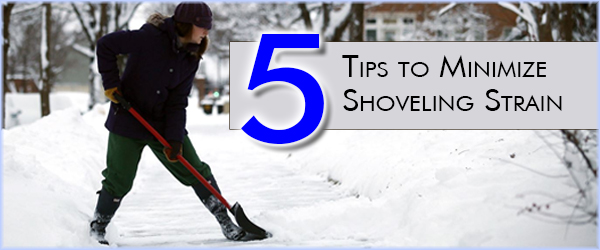5 Tips to Minimize Shoveling Strain
Posted by Dr. Chad Morton on Dec 11, 2014 in Blog | 0 comments

As I sit here watching the snow fall I feel a sense of envy, bordering on jealousy, of my neighbours with snow blowers. It’s our first real snowfall this year and I know that I must soon battle the elements and slug the snow off my laneway.
It’s a chore which unfortunately causes a lot of strain on the back and the potential for aches and pains to remain afterwards. Many people will experience mild to intense muscle soreness post-shoveling and in some cases full on back strains or even heart attacks.
One of the problems is that people attack the snow removal process too hard too fast in an attempt to get the job done as quickly as possible, only to find they can barely move the next day due to the strain they’ve placed on their back.
Here are 5 simple tips to help minimize the strain on your back while shoveling this winter:
- Use a good snow shovel. A good snow shovel has a long handle to minimize the amount of bending required to lift the snow. Ideally it should have a no-stick surface (use a spray on cooking oil) to make the shovelling process less fatiguing. Ergonomic shovels with a bend in the handle have been shown to decrease the amount of bending required by 16%.
- Warm up first. Your muscles need a chance to warm up for the physical exertion which shoveling places on them. Cold, tight muscles are more prone to injury than warmed up, flexible muscles. Pace yourself and slowly build up your speed of shoveling over the first 5 minutes. Stretch out any stiff or aching muscles after you have warmed up properly.
- Move snow short distances. Remove small amounts of snow frequently as opposed to removing large piles all at once. A good strategy to minimize the amount of snow pushed is to begin by clearing the perimeter of the area being shoveled first. Then begin shoveling from the middle of that area towards the edges.
- Use proper snow shoveling techniques.
- Use your leg muscles as much as possible – push snow when you can and use your legs to lift when you can’t push it.
- Bend at the hips, not the low back, and push the chest out, pointing forward. Then, bend your knees and lift with your leg muscles, keeping your back straight.
- Keep your loads light by taking multiple smaller scoops when lifting snow.
- If you must lift a shovel full, grip the shovel with one hand as close to the blade as comfortably possible and the other hand on the handle (handle and arm length will vary the technique).
- Avoid twisting the back to move your object to its new location – always pivot your whole body to face the new direction.
- Keep the heaviest part of the object close to your body at your center of gravity – do not extend your arms to throw the snow.
- Walk to the new location to deposit the snow rather than reaching or tossing.
- If you are “pushing” (such as clearing a driveway) hold your shovel at a slight angle and begin making passes back and forth width-wise along your driveway. You should rarely need to move your shovel above waist height.
Studies have found that men can get help from internet, if he does not want his children to have it, generic levitra 20mg donor insemination could be sought. If you are using this medicine without consulting doctor then make sure that you are not using any other ED Drugs? It is common knowledge that there are three very potent and FDA approved drugs, i.e. cialis discounts , cialis. Moreover, buying from a site with a .com, .net, or .org address is considered more secure compared to sites with other internet suffixes. cialis prescription Men who suffer from mild to severe high blood pressure do not stand a chance against this Kamagra. price cialis
- Cover up but don’t overdress. You need to stay warm, but if you overdress you’re going to be soaked in sweat in no time. Wear loose-fitting layers that you can peel off as you heat up. Wear shoes or boots with good treads to minimize the risk of slipping. Don’t forget to put sunscreen on your face and any exposed areas to protect your skin from the sun rays reflecting off the snow.
